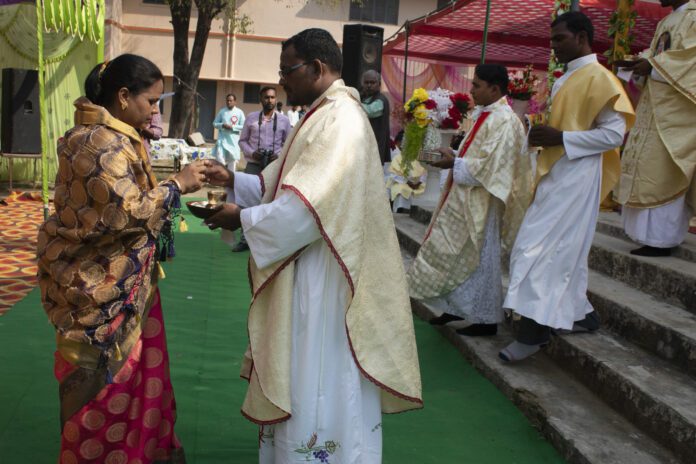NEW DELHI (RNS) — When riots engulfed Tiangia, a village in remote Kandhamal in eastern India, in 2008, Vikas Nayak was 15 years old.
Nayak sought refuge in the area’s dense tropical forests as marauding mobs of Hindu fanatics set fire to hundreds of Christian homes in his village. He heard the mobs chanting slogans as they killed Christians, attacked churches and torched properties using rods, swords, tridents, guns and kerosene crude bombs.
“Those images haunt me every day,” said Nayak, now 29, who spent three years in the tattered canvas tents of relief camps after the riots.
“Even though the camps were guarded by army personnel,” he remembered, “we were living in perpetual fear of more attacks and practiced our faith behind closed doors.”
After the savagery of the riots subsided, Nayak went to Varanasi to begin training as a priest. He immersed himself in spiritual discourses, meditation and Indian classical music.
The next few years of his formation were spent in different cities learning philosophy and theology. He visited families, organized youth prayer meets and spent time in prayer.
Last November, Nayak was ordained by the archbishop of Patna Diocese in the neighboring state of Bihar, becoming the first Catholic priest to emerge from a relief camp in Tiangia.
The Kandhamal riots of 2008 stand out as a watershed moment in India’s history of mass violence against minorities.
The flashpoint for the riots was the murder of a Hindu nationalist leader who is alleged to have been campaigning against missionaries and working to reconvert low-caste and poor Christians who had turned away from Hinduism to escape caste oppression.
Hindu extremists blamed the murder on Christians, even though it was widely believed to be the result of an attack by leftist insurgents. Christians were named “conversion terrorists.”
In the riots, more than 100 low-caste and Indigenous Christians were hacked to death or burned alive; more than 300 churches were demolished. Women were raped, religious texts were destroyed and Christians were forced to convert to Hinduism.
“Those memories can’t be washed away, but we mustn’t allow our ties to break further,” Nayak told a roomful of congregants who had turned up in colorful attire for his first Eucharist after his ordination.
In Kandhamal, where 59% of inhabitants live below the poverty line and depend on daily wage labor in agriculture, construction and domestic work, many families were expelled from their villages permanently.

Remains of a Christian church property burned down during violence in Orissa, India, in August 2008. Photo courtesy of All India Christian Council/Creative Commons
The riots not only devastated the Christian community — particularly economically marginalized Indigenous and low-caste Christians — but accelerated Hindu majoritarian movements and hate crimes against minorities.
Last year, the United Christian Forum for Human Rights reported 505 incidents of violence against Christians in the country, and the Evangelical Fellowship of India said anti-Christian hate crimes have doubled since 2014, when Narendra Modi became the prime minister.
Under Modi, minorities are increasingly being targeted and threatened, and attacks on pastors by Hindu extremists have become common. Not only are they prevented from holding religious services; they are regularly beaten up and charged with criminal conspiracy.
Nayak’s example has bolstered his former community during this difficult time for Christians.
After the 2008 riots, Nayak fled his village but had no idea whether his family had been captured by the rioters. After hiding in a forest for a fortnight, he walked miles to find shelter at a village school. A month later, he found his way to a relief camp for survivors in a neighboring district.
There, Nayak immersed himself in prayer and tried to stitch his life back together amid other displaced families that had been evicted from their villages and farmlands by irate Hindu mobs. He wrote about living like a refugee in his own land.

